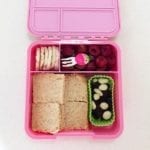Child Nutrition
Plan for an empty lunchbox and take the sting out of getting ready for school
Plan a weekly lunchbox menu together with your kids using a few easy steps
Step 1
Set some ground rules about what needs to go in the lunchbox and what will stay out. Things like:
- It includes at least 1-2 vegetables every day
- There can be no packets
- Jam sandwiches are only on Fridays
Step 2
Make 2 lists of vegetables together. The first is a list of their favourite vegetables and the second list of vegetables that they think are OK.
Plan to have one of the favourite and one of the ‘OK’ veggies in the lunchbox each day. Regularly having the ‘OK’ vegetables in there increases their taste for them so they eventually move over to the favourite list. Don’t be worried if the ‘OK’ vegetable comes back every day for a while. The more they see it (and sometimes have a bite or two), the more they will like the taste. This is the foundation of helping kids develop healthy eating habits that will last a lifetime. Think about the first time you tried beer or coffee. It didn’t taste too good to start with but we persisted until eventually we couldn’t live without it! 🙂
Step 3
Make a list of carbohydrate foods that they like and what would work well in a lunchbox. Are they willing to try a healthier alternative? Would they like to taste or try it at home before adding it to their lunchbox. Talk about healthy alternatives including:
- Grainary or wholemeal bread and wraps
- High fibre crackers e.g. Ryvita, Vita-wheat
- Brown or basmati rice
- Wholemeal pasta and spaghetti
- Baked beans
Step 4
Make a list of favourite fruits that will fit in the lunch box.
Use sealable containers so that it can be chopped up and kept fresh. Limit fruit to one medium sized fruit and save the other portion of fruit for after school or after dinner.
Step 5
Choose a high protein food. A small portion (child-sized) is all that is needed and it will help to keep them full through the afternoon. Stick to healthy and lean meats that can be kept cool and safe in the lunchbox. You can also pick up a cheap food thermos to keep food hot if you prefer. Some examples are
- Tinned tuna/salmon and light mayo
- Ham
- Cheese
- Roast or baked chicken breast
- Baked beans (hot or cold) – and yes baked beans are both a meat alternative (protein source) and carboydrate (energy and fibre source) all at the same time!!
Step 6
Put all the lunchbox ideas into a weekly timetable and stick it on the fridge. Kids like predictability so you might want to repeat the lunchbox ideas on the same day every week. You can make it a regular thing to sit down every school holidays to plan the next term’s ‘menu’.
Having a timetable also makes putting your shopping list together a bit easier as well. You can download a copy of these tips (useful when you sit down for your planning session) and a page to record your menu in the link below
Where is the treat?
Before you start adding high sugar or fat treats like biscuits, cakes, chocolate, juices or lollies to the lunchbox, ask yourself, ‘What part of my child’s body or mind will this food nourish?’ They give energy but if the lunchbox has all the ingredients discussed above then your child’s energy needs will be met. If you think they need more then increase the portions and it will also give them the extra B vitamins and fibre that they need to go along with it.
Perhaps you feel that children need to have sweets just to make them feel good. We all love to see our children smile but using food as a reward can set up a lifelong habit of comfort eating and unwanted weight gain when they are older. It is a hard habit to break as an adult so better to not create the habit in the first place. Fruit gives children the balance of sweet food that is nice in a meal. Try writing a joke on a post-it, a small toy or even using art and craft materials to put a smile on their dial!

HAPPY PLANNING!

